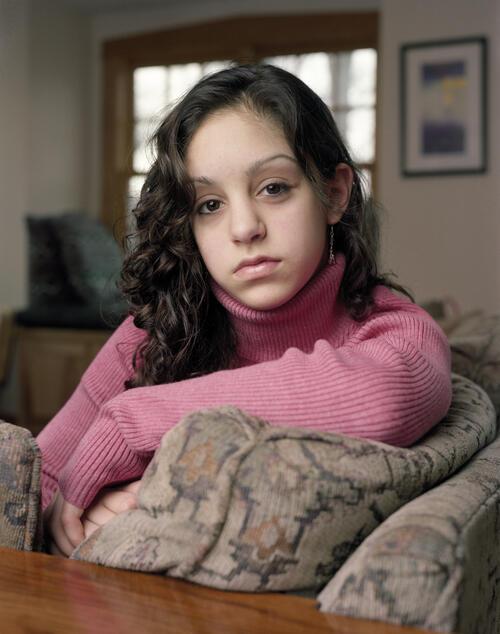Claire
Claire
"Claire" by Dawoud Bey, 2004
Dawoud Bey, Claire, 2004. Pigment Print, with interview by Dan Collison and Elizabeth Meister.
Image courtesy of Dawoud Bey.
Commissioned by the Jewish Museum for the exhibition The Jewish Identity Project: New American Photography.
Claire Saxe Interview excerpts
My name’s Claire Saxe, I’m 16 years old.
My father is mostly Russian, and my mom is I think about half Russian, my grandmother is part Native American. She’s Ojibwe and lives on an Indian reservation in northern Wisconsin.
I’m not very religious. I think 3/4 of my family either is or was Jewish at one point in their life, but I’m not really religious at all. Whenever people ask what religion I am, I mention that parts of my family are Jewish but I’m not religious, but I think culturally I identify more with being part Native American than I do with being part Jewish. Which is interesting, because I’m such a small percentage Native American, but I think just because I’ve been to the reservation every year since I was a baby, I’m so familiar with the culture and everything because of my grandma, it feels closer to me than Judaism does.
In 6th grade I did research on Ojibwe religion, ‘cause when all my friends were getting Bat Mitzvahed and I was like well, maybe I can find something of my own. And it wasn’t really what I had sort of romanticized it to be, but there’s still something that it has been in my head all these years that I like, and I’m not really sure what you’d call that. I mean, I really like the idea of being connected to nature and your surroundings, and acknowledging the life of everything around us, and it’s sort of spirit and existence. I find that really comforting, you know feeling at home, and feeling like I’m not alone when I’m in a forest surrounded by trees, because everything around me is alive…
When I was about 13 and all my friends were getting Bat Mitzvahed I was kind of upset, and I asked my mom why she hadn’t made me Jewish when she had the chance. And I guess part of me does still want that a lot, sort of wants to have that identity, to have that part of myself more concretely. But religion now isn’t a part of my identity so much, because I didn’t have any sort of religious experience growing up. So I don’t think I need it, I’m not dependent on it. But if I grow up and find something that feels right, I think I would like to have that as part of who I am, and to pass on to my children, so they do have that. And since such a large part of my family and a large part of my ancestors were Jewish, I’d probably investigate that first. But it’s not something that I'm yearning for and that I need, because it's not something that I've had my whole life.
An excerpt from an interview with Claire Saxe, 2004, conducted by Dan Collusion and Elizabeth Meister, which accompanies the photograph Claire by Dawoud Bey.
Discussion Questions (Part 1) - Looking at the Photograph
- Describe what you see in this picture. How is this girl posed? What is she wearing? Where is she sitting? How would you describe her expression?
- What do you think this girl is communicating to you as the viewer?
- Does she seem approachable? Reserved? Other?
- Based upon what you see in the picture, what assumptions might someone make about the identity of this girl? What is the basis for those assumptions?
Discussion Questions (Part 2) - After Reading Transcript
- If Claire Saxe was to do the 5 part identity activity we did earlier, how might she have filled out her card?
- What parts of her identity have caused Claire to do research about her people and religion? Do you think the research has helped her become more comfortable with who she is? Why or why not?
- Describe a situation in which what others were doing has caused you to question some part of your identity.
- Only a fraction of Claire's heritage is Ojibwe but this is the strongest part of her identity. What has reinforced this part of her identity? How do you think experiences in our lives help shape our identity?
- What is an experience that has helped shape your identity?
- Revisit the assumptions made about Claire Saxe before you read her transcript. How many of the assumptions were correct? How many were inaccurate? To what degree do we judge someone else's identity by visual clues and/or names?



